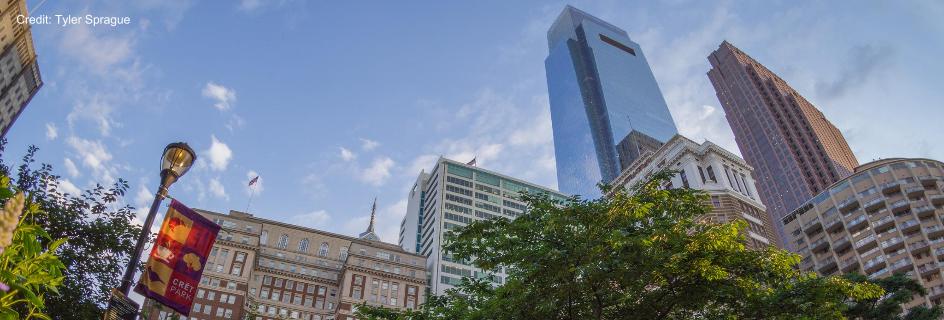- About GPA
- Global Events
- GLOBAL NEWS FROM PHL
- Global Directory
- World Heritage City
- Sustainable Development Goals (SDGs)
- Global Philadelphia Role on Sustainable Development Goals
- Completed Sustainable Development Goals
- SDG#1: No Poverty
- SDG #2: Zero Hunger
- SDG#3: Good Health & Well-Being
- SDG#4: Quality Education
- SDG#5: Gender Equality
- SDG#6: Clean Water & Sanitation
- SDG#7: Affordable and Clean Energy
- SDG #8: Decent Work and Economic Growth
- SDG #9: Industry, Innovation, and Infrastructure
- SDG#10: Reduced Inequalities
- SDG#11: Sustainable Cities and Communities
- SDG#16: Peace, Justice and Strong Institutions
- SDG#17: Partnerships for the Goals
- Press
Home ›
Carpenters’ Hall in Philadelphia: A Crossroads for Early American History
Posted on August 3, 2023

By Enya Xiang
In Old City, Philadelphia, Carpenters’ Hall was the site where Founding Fathers frequented and where early America took shape. The National Historic Landmark was and still is home to the Carpenters’ Company, a group of master builders who laid the foundations for Philadelphia’s first buildings and sites that were home to many of the nation's most pivotal moments.
Finished in 1774, the charming, symmetrical Georgian building contains two stories. Upon entering, two wooden chairs are displayed on the left, relics of the First Continental Congress in 1774: the “comb-back” chair, used by Peyton Randolph, President of the Congress, and the “sack back,” used by the delegates. Crammed into one half of the Hall, fifty-six delegates met from twelve colonies, excluding Georgia, to discuss America’s future.
In the center of the room, a model of the Hall, created by the Hagley Museum, shows figurines scattered across a scaffolding, depicting eighteenth-century builders in tricorn hats constructing the roof. This scene is a reminder that history is deeply connected to the material world around us. “The mashup of history, the American Revolution, and the start of democracy connects to the physical development of Philadelphia,” recognizes Michael Norris, executive director of Carpenters’ Hall.
The ways that form and space are used also create opportunities for movement, choices that transform historical legacy. In the late eighteenth century, Carpenters’ Hall was the one of the largest available rental spaces. Its practicality as a gathering space unexpectedly put the Hall in the heart of revolutionary politics.
During the Revolution, the Second Continental Congress realized that the American army needed foreign aid. Representing his monarch, the French spy Julien-Alexandre Achard de Bonvouloir arrived in Philadelphia to vet the rebel forces and report back to his government. It was understood that if he was exposed, France would deny any involvement.
On the second-floor library at Carpenters’ Hall, Ben Franklin and John Jay met Bonvouloir over the course of three meetings in December of 1775. In those meetings, Francis Daymon acted as interpreter for Franklin and Jay. Franklin had hired Daymon, a Frenchman, to work as the librarian for his Library Company, which occupied the second floor of Carpenters’ Hall at the time.
The only record of what was said at the meetings was Bonvouloir’s report to the French minister of foreign affairs, which states that the American soldiers “have an unbelievable eagerness and goodwill: it is true they are led by capable people.” He continues enthusiastically, “Nothing shocks or frightens them, you can count on that. Independency is a certainty for 1776; there will be no drawing back.”
The report secured financial and military aid from France and eventually led to the critical alliance between France and the American colonies in 1778 that ensured the new nation’s victory.
Carpenters’ Hall was the site of another crime, the United States’ first bank robbery in 1798, during when the building was the temporary rented home for the Bank of Pennsylvania. Between the night of August 31st and morning of September 1st, a sum of $162,821 was taken from the vaults at Carpenters' Hall. There was no sign of forced entry into the building or the vault—someone was on the inside.

An innocent suspect, blacksmith Patrick Lyon, spent three months in the Walnut Street Prison, but the true culprit was later discovered. Isaac Davis, a member of The Carpenters' Company, was caught when he began depositing the missing money into local banks, including the very bank he had robbed. His partner was Thomas Cunningham, a bank porter who slept in Carpenters' Hall the night of the robbery.
The intrigue of Carpenters’ Hall continues today. In April 2022, the Hall underwent preservation and restoration efforts, but on Christmas Eve of that year, the building suffered an arson attack. Right when the project was nearing its completion, the Hall was forced to close for another six months.
Carpenters’ Hall reopened on July 3rd, 2023, with a new exhibit Artifacts and Architecture showcasing its history, preservation, and uncovered artifacts. The Hall is also preparing to celebrate the 300th anniversary of the Carpenters’ Company and the 250th anniversary of the First Continental Congress in 2024.
The arson attack remains unsolved. Norris jokes, “I’ve learned that everyone should have sprinklers.” Luckily, the Hall, now installed with security cameras, has a sprinkler system in place to reduce damages. He remarks that the opening not only welcomed many tourists but also drew many locals from the city.
“History is central to Philadelphia’s identity,” acknowledges Norris. The Carpenters’ Company, still active, continues to set the standards for building design and construction in Philadelphia. Franklin’s Library Company still operate as a free research library, supported by shares owned by local Philadelphians.
As centuries pass, new shareholders may take on the stakes of those who have been long deceased. Which share did Norris decide to choose? Daymon’s, the French interpreter who attended the secret meetings in the early revolutionary years on the second floor of Carpenters’ Hall.







